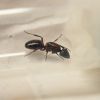1. Location of collection: Flint MI
2. Date of collection: Aug 27 10 am
3. Habitat of collection: Crawling down hotel wall
4. Length (from head to gaster): 15mm
5. Color, hue, pattern and texture: black/dark brown head, orange thorax, black/brown gaster
I have had her in a test tube thinking she is a novaeboracensis, but its been over a week and nothing. any ideas. thanks. Very new at any keeping/ hobby.
Edited by antnothinglikeit, September 5 2016 - 11:24 AM.

















